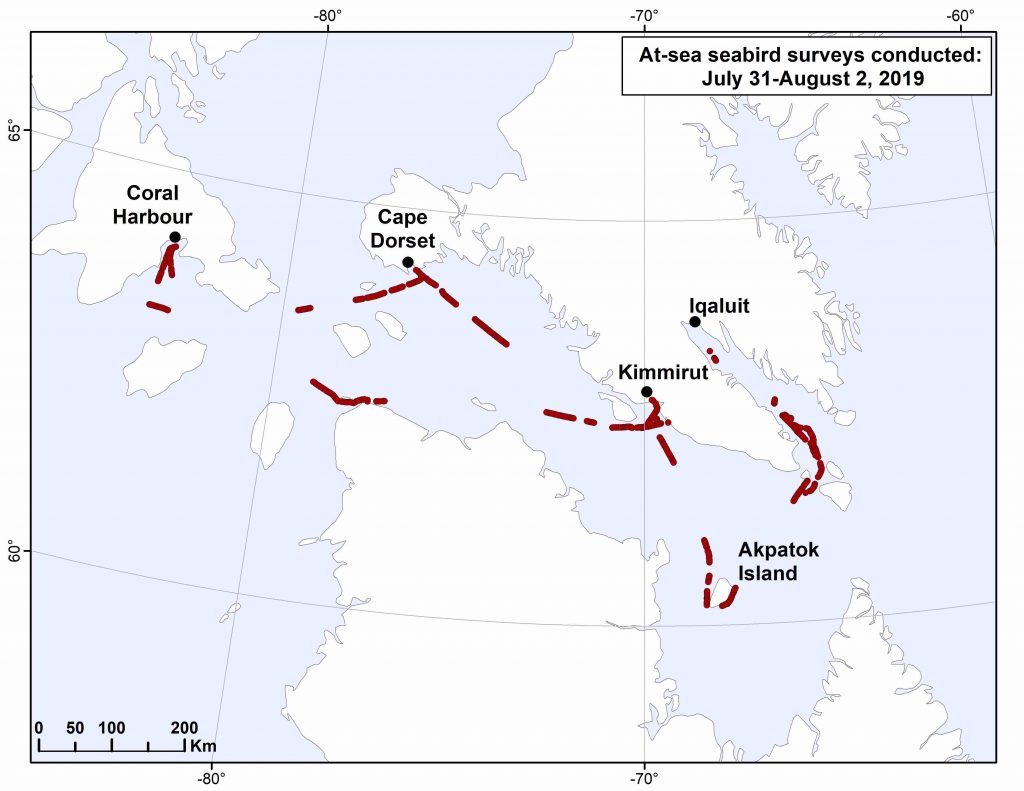In summer 2019 we welcomed Sarah Wong, a wildlife biologist with the Canadian Wildlife Service (CWS) on board the “South Baffin Explorer – Art, Culture and Wildlife” voyage to conduct a survey on Arctic birds. Here is her account of the research that she conducted whilst on the ship.
I just recently returned from a productive and fantastic trip to the Arctic with One Ocean Expeditions. For the entire 11 days, I was conducting seabird/ Arctic bird surveys while the ship was moving. Twenty million seabirds are found in Canadian Arctic waters. With researchers at Acadia University, we are trying to learn more about how seabirds live and move through these important marine areas and gain a better understanding of the threats they face. As part of CWS’s monitoring and conservation program for birds at sea in eastern Canada, we maintain the Eastern Canada Seabirds at Sea database, which contains surveys dating back to 2006. However, survey efforts in the Arctic are limited.

In collaboration with One Ocean Expeditions, our survey effort has extended into remote regions of the Arctic. In fact, our trip, which ventured through Hudson Strait and into Hudson Bay, allowed me to survey an area that hasn’t been surveyed since the 1970s! Much has changed in the Arctic landscape over the last fifty years and monitoring seabird distribution and abundance helps us to identify important marine areas for protection and understand the consequences of climate change on Arctic marine bird populations.
Between exciting visits to the communities of Cape Dorset and Kimmirut, marvelling at over 400 walruses on Walrus Island, visiting Thule sites and spotting polar bears (9 in total!), I spent all of my time on the bridge, conducting surveys. These surveys (often beginning at first light– 4 am!) follow a standardized protocol and over the course of the trip, I surveyed over 900km and recorded nearly 6,500 birds.
Among the species recorded were Northern Fulmars, Black-legged Kittiwakes, Black Guillemots, Common and King Eiders, Herring, Glaucous and Iceland Gulls, Red Phalaropes and even a Sabine’s Gull! But 94% of the species recorded were Thick-billed Murres. The overwhelming numbers of Thick-billed Murres came as no surprise, as we were lucky enough to pass by two of the largest Thick-billed Murre colonies in Canada: Digges Sound (last estimated to have 400,000 breeding pairs) and Akpatok Island (~520,000 pairs). That’s over 50% of the Canadian population of Thick-billed Murres! Weather conditions allowed us to do a zodiac cruise along the steep cliffs where each pair lays a single egg on the bare rock. We kept a sharp eye out for any chicks. At just three weeks of age, before the chick is fully grown, the young bird leaps from the edge of the cliff and joins the male parent on the water below. Together, they start the long journey south to their wintering areas off eastern Newfoundland and Labrador. It makes me feel pretty lazy taking a plane back to my home in Nova Scotia.

We rely on ships for the opportunity to conduct our seabird surveys and are thankful for the support of One Ocean Expeditions. The data I collected will contribute to ongoing monitoring efforts aimed at assessing the status and trends of migratory bird populations in the Arctic. We look forward to future surveys onboard with One Ocean Expeditions.”
Thank you Sarah for sharing your fascinating research with us!
One Ocean Expeditions has a commitment to aiding researchers to conduct their studies in order to help protect the fragile polar environments. If you are interested in travelling with us, and witnessing some world-class research, speak to your preferred travel agent, or contact us here.















